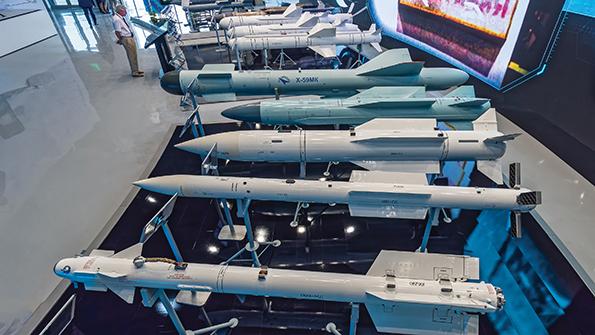
Moscow-based GosMKB Vympel, which designs air-to-air missiles, is funding its own research on what appears to be the continuation of a short-range missile project that had been halted decades ago.
- Work would pick up the previously canceled K-30 program
- Modernization of the engine, seeker and control system likely
In late January, the company summarized its research and development work conducted in 2020. The most interesting project appears to be its research on “shaping the appearance of a future product 300M.”
This work, financed by Vympel’s long-term development fund, is to lay the scientific and technical groundwork for the Russian military and increase the company’s export prospects, the company says.
Undoubtedly, the current izdeliye 300M (“izdeliye” means “product” in Russian) is a further development of the K-30, or K-MD, short-range missile project, launched by Vympel in 1986 as part of its work on arming the fifth-generation MiG multirole fighter, which was halted in 1994 due to a lack of funding.
Later, Vympel offered the 300 project while working on how to arm the Sukhoi PAK FA (Su-57) fighter. In 2006, the company said the 300 missile could have been ready in 2013, if enough funding had been available. Gennady Sokolovsky, the head of Vympel at the time, said that the 300 missile would “significantly exceed foreign missiles of a similar type.”
The 300 was to be fitted with a new Merlushka, or “lambskin,” imaging infrared seeker developed by the AOMZ tactical missile company, enabling target identification and a lock-on range twice as great as its predecessors. The dual-pulse, solid-propellant motor was to provide relatively large specific impulse (about 100s), a measure of the engine’s efficiency. The 300 missile was to have jet-vane gas controls instead of spoilers placed in the engine nozzle, as is the case with the current R-74 missiles. The efficiency of the variable gas nozzle is greater than that of spoilers; moreover, the presence of spoilers in the nozzle causes a loss of thrust.
Judging from the course of events, plans to resume the 300 project were not approved at the time, and the simpler R-74M2, otherwise known as izdeliye 760, was chosen as the primary close air-combat missile for the Su-57.

How the current 300M project changed compared with the previous version is not known, but most likely the modifications did not alter the overall configuration. If the changes were really significant, the project would have received a new index, not just an additional M letter.
Certainly, the element base in the seeker and control system is new; the engine also may be improved. Of course, the 300M missile remains at the conceptual research stage, which usually does not yet involve the actual construction of a missile.
According to Vympel’s announcement, another short-range missile performed “about 30 firing tests” in 2020 as part of state evaluations, the final stage of tests before the missile is approved for full-scale series production. The announcement probably refers to the R-74M2, izdeliye 760, missile, which started firing tests on April 8, 2016, and in July 2019 was submitted for state evaluations on the Su-57. The Vympel R-74M2 is a further development of the in-service R-74M izdeliye 750 with the cross-section reduced so it can be fitted inside the internal quick-launch weapons bays of the Su-57.
The remaining information provided by Vympel about its 2020 research and development work is very general. The types of weapons are not named, and only the categories are defined. In the long-range air-to-air missile class, one of the missiles “completed preliminary tests to the extent sufficient for the construction documentation to be awarded the letter ‘O.’” In the parlance of the Russian defense industry, the letter “O” denotes permission to make an initial serial batch of missiles. Vympel could be referring to a new-generation heavy missile, the izdeliye 810, intended for internal carriage in the Su-57 fighter. The 810 missile, never presented to the public, began undergoing firing tests on July 6, 2017; its maximum range is estimated at 300 km (186 mi.).




